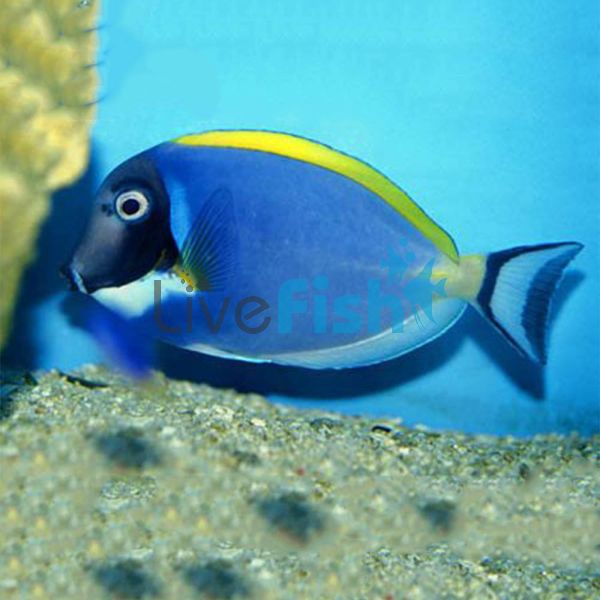Tang Powder Blue - Medium
The distinctive appearance of the Powder Blue Tang catches the eye immediately. Its combination of colours really makes it stand out. The oval shape body is a powder blue colour. The dorsal fin is yellow with pale blue trim, and its anal fin is pale blue to white. Its tail fin is white with a black outline, the caudal peduncle and pectoral fins are yellow. It has a black face and white chest with the white often running up behind its eye. The Powder Blue Tang has spines in its dorsal fin, pelvic fins, anal fin and either side of its caudal peduncle. There is also a spine near the tail, but none of the spines is venomous.
Powder Blue Tang
The distinctive appearance of the Powder Blue Tang catches the eye immediately. Its combination of colours really makes it stand out. The oval shape body is a powder blue colour. The dorsal fin is yellow with pale blue trim, and its anal fin is pale blue to white. Its tail fin is white with a black outline, the caudal peduncle and pectoral fins are yellow. It has a black face and white chest with the white often running up behind its eye. The Powder Blue Tang has spines in its dorsal fin, pelvic fins, anal fin and either side of its caudal peduncle. There is also a spine near the tail, but none of the spines is venomous.
Female Powder Blue Tangs are usually larger than the male. They mate in pairs and are open water spawners. During mating, a pair will rise to the surface to release gametes. When the larvae grow to 1 inch, they become juvenile. At this point, they will start to return to the reef, which provides more protection and food.
Powder Blue Tangs are distributed across the Indian Ocean and Western Pacific. Locations include Africa, Maldives, Indonesia, and Christmas Islands. Their natural habitat is in shallow coral reef areas between 0-25 metres.
Tank Recommendations for Powder Blue Tangs
Tank size needs to be at least 6 feet long and 125 gallons (473 litres).
This is not an easy species to take care of. Avoid using active carbon which is linked to Lateral Line and Hole In The Head disease.
They need a mature tank containing plenty of Algae and Live Rock for grazing, hiding, and shelter. Powder Blue Tangs are extremely active swimmers so a tank should have plenty of open space. Strong water movement across the tank will offer resistance for them to swim into. They will get too big for a nano tank but are suitable for reef and fish only tanks.
Suitable Tank Buddies
Powder Blue Tangs are semi-aggressive. They are more aggressive than many Tangs, although not the most aggressive. Personalities vary with this species so a lot of it depends on the specimen in your tank. They can show aggression to other Tangs which can make them sick in the process.
Usually Compatible
Small peaceful fish such as Dartfish, Gobies and Fairy Wrasse should be fine. The same applies to semi-aggressive fish such as Clownfish, Dwarf Angels and Anthias.
Sometime Compatible
Aggressive fish and larger semi-aggressive fish will need monitoring. Bigger Dottybacks and Damsels may bully. Wrasse can cause the Powder Blue Tang stress from their constant swimming. Only house with planktivore Angelfish. Attempting to cohabit with Tangs of a different genus will need an exceptionally large tank.
Rarely Compatible
Do not attempt to co-habit conspecifics. Large predators like Groupers, Soapfish and Lionfish are a threat to Powder Blue Tang. Seahorses and Pipefish are too delicate.
Feeding Your Powder Blue Tang
Powder Blue Tangs are herbivores in the wild and consume a large number of vegetables and algae. They will also eat meaty foods such Mysis Shrimp, but the bulk of their diet should be plant-based. A suitable diet should contain algae and spirulina. This can be natural or in the form of frozen formulas, flakes, or pellets. Seaweed such as Nori can be attached to the tank with a vegetable clip. Treats can take the form of lettuce, broccoli, zucchini, and fruit. Feeding should occur 3 times per day.
| Scientific Name | Acanthurus Leucosternon |
|---|---|
| Care Level | Moderate |
| Common Names | Powder Blue Tang, Powder Blue Surgeonfish |
| Diet | Herbivore |
| Fish Family | Acanthuridae |
| Lifespan (years) | 5 |
| Max. Length (cm) | 23 |
| Min. Tank Volume (l) | 473 |
| Origin | Indian Ocean and Western Pacific, Africa, Maldives, Indonesia, and Christmas Islands |
| Reef Safe | Yes |
| Sociability | Semi-aggressive |
| Venomous | No |
| Water Conditions | 23.3-28.3° C (74-83° F), dKH 8-12, pH 8.2-8.4, sg 1.023-1.025 |




